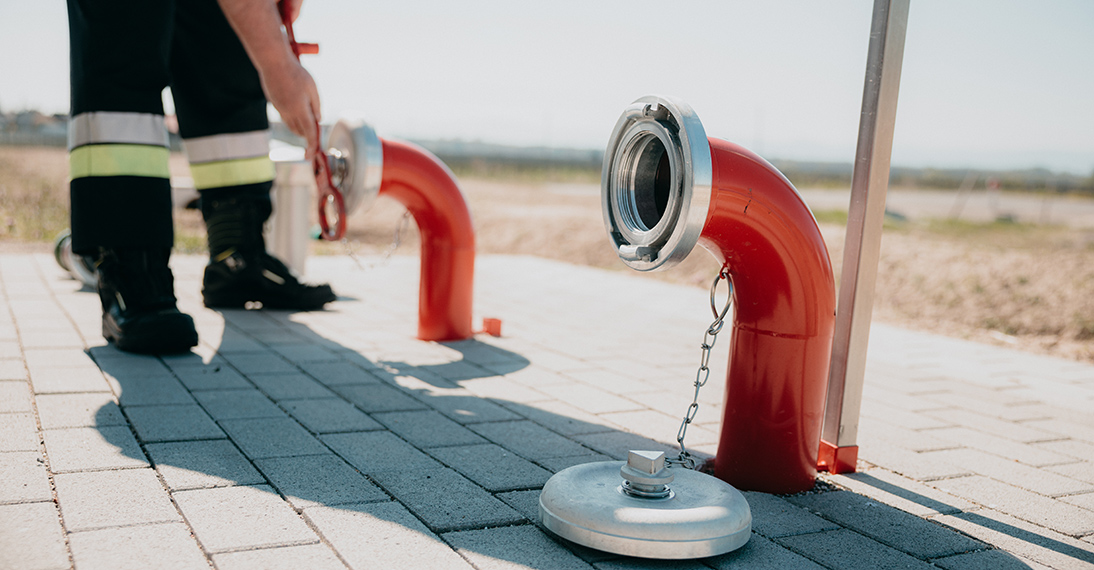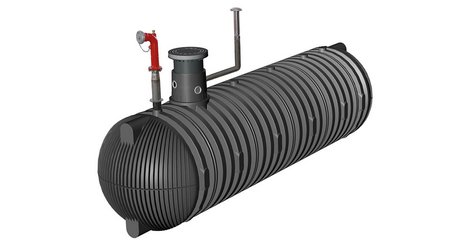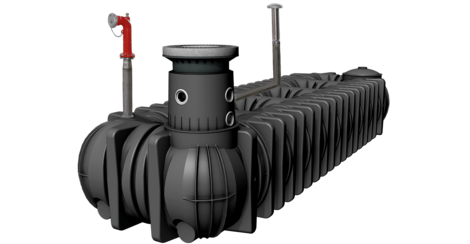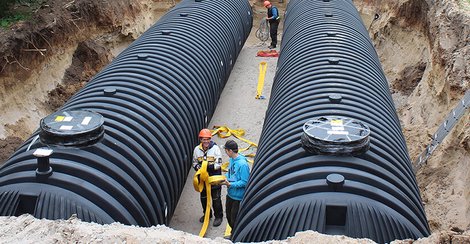Rainwater March – The Vogtsburg Fire Brigade Practices with Rainwater from a GRAF Tank
As part of the construction of their new station, the Vogtsburg fire brigade has installed the Carat XXL fire water tank. Firefighters can now use rainwater from their own roof during their exercises.
Only two red fire hydrants, two stainless steel ventilation chimneys, and a sign reveal that the heart of the Vogtsburg fire station lies dormant beneath the light grey paving stones. Every move is precise as firefighter Christoph Möcklin opens the above-ground hydrant with a red multi-tool and connects a black suction hose. A few button presses later, a pump starts rattling. ‘Now water is flowing,’ explains the firefighter, ‘Rainwater.’
There is a hint of pride in Christoph Möcklin's voice as he explains that all the rainwater from the roof of the newly built fire station in the Oberrotweil district of Vogtsburg is channeled through underground pipes to the edge of the car park. This is because a Graf Carat XXL fire water tank is buried there, 1.5 meters below the surface.

The Graf tank can hold 22,000 litres of rainwater. It therefore serves not only as a water reservoir for training purposes, but also to relieve the sewer system during heavy rainfall. Despite its size, the tank was easy to deliver and install underground thanks to its light weight. A must-have for the fire brigade. When they draw water from the suction connection during their drills, they have to drive close to the connection. The tank system can withstand vehicles with a total weight of up to 40 tonnes.
The pump is still rattling as Christoph Möcklin talks about the lengthy planning process for the new station. Initial discussions between the local fire brigades in the town of Vogtsburg began back in 2017, until a location for a large joint station was finally found on the outskirts of Oberrotweil in June 2020. Christoph Möcklin was involved in the planning from the outset. He has been an active member of the Vogtsburg fire brigade since 1980 and knows what a modern fire station needs. One item that was high on the wish list, says Möcklin, was a dedicated water tank for training and exercises.
In the past, firefighters had to drive 10 kilometres to Breisach on the Rhine, for example. There, a tank ramp enabled training for the fire brigade's machine operators. However, this was time-consuming and also difficult due to a lack of lighting. Often, equipment and firefighters would get dirty from the exercises on the muddy banks of the Rhine. That is why the firefighters, together with the municipality and the architect, planned their own tank on their premises that can be used for exercises.
‘If we were just testing the pump today, we would feed the water back into the tank via the water return system,’ explains Christoph Möcklin, pointing to the left of the two red connections on the floor. This is because when only the pump is being tested, the firefighters do not need to spray water. Today, however, firefighter Achim Grafmüller is spraying water after all – to demonstrate how well the system works. The jet shoots in a high arc towards the photographer and trickles down to the ground in fine droplets. When the water reaches the rain gutter, it flows straight back into the firefighting water tank. Sustainability was also an important consideration in the construction of the station.

The building is partly made of wood and has a solar panel system and heat pump, so it was ‘the right choice,’ says Christoph Möcklin, to go with GRAF, a local company that makes tanks from recycled plastic, for the fire water cistern.
The short drill is now over, and Achim Grafmüller directs the remaining water back into the cistern while his colleague Robin Kaiser rolls up the hose. Everything went according to plan. Christoph Möcklin agrees: ‘Now everything is exactly as we wanted and hoped’.









